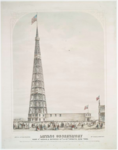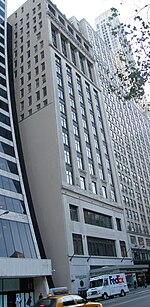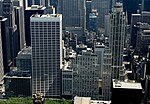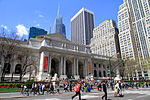Bryant Park restroom
42nd Street (Manhattan)Bryant ParkMidtown ManhattanNew York City Designated Landmarks in ManhattanRestrooms in the United States ... and 1 more
Use mdy dates from December 2023

The Bryant Park restroom is a public toilet in Bryant Park, an urban park in the New York City borough of Manhattan. The 315-square-foot (29.3 m2) structure was built at the same time as the New York Public Library Main Branch and designed by the same architects. It opened in 1911 and closed in the 1960s as the surrounding park deteriorated. It was restored in the 1990s and underwent renovations in 2006 and 2017, modeled after luxury hotel bathrooms. With flowers, automatic toilets, original artwork, classical music, and an attendant, it is often regarded as among the best public bathrooms in the city, used by more than a million people per year.
Excerpt from the Wikipedia article Bryant Park restroom (License: CC BY-SA 3.0, Authors, Images).Bryant Park restroom
West 42nd Street, New York Manhattan
Geographical coordinates (GPS) Address Website Nearby Places Show on map
Geographical coordinates (GPS)
| Latitude | Longitude |
|---|---|
| N 40.753889 ° | E -73.9825 ° |
Address
Bryant Park
West 42nd Street
10018 New York, Manhattan
New York, United States
Open on Google Maps










